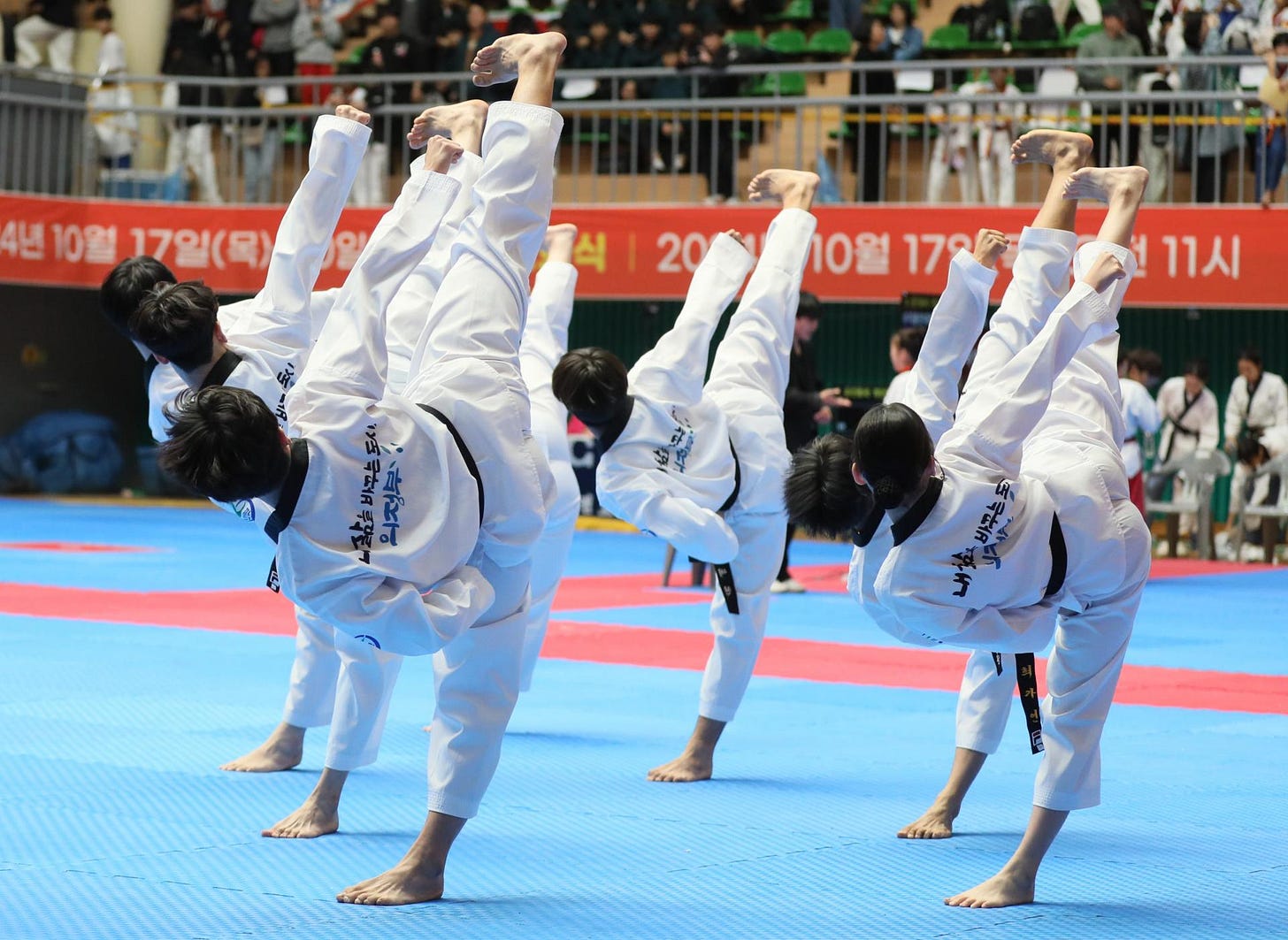What are Martial Arts?
From my prologue of A Brief History of Korean Martial Arts, here is a closer look at the definitions of the subject at hand.
Before diving into the complex and fascinating history of Korean martial arts, it’s worth pausing to ask a surprisingly tricky question: What exactly are martial arts?
The term is instantly recognizable—but often misunderstood. Popular images come to mind: gravity-defying kicks, dramatic board breaks, or flashy performances designed to wow a crowd. Others think of intense cage matches or combat sports. These modern representations, while exciting, barely scratch the surface.
They tell us what martial arts look like today—but not what they truly are.
Taekwondo practitioners perform a synchronized side kick during a demonstration by the Gyeonggi-do Taekwondo Association, Republic of Korea. (Photo Credit: © Gyeonggi-do Taekwondo Association)
At its core, martial arts is not about spectacle. It’s about survival, discipline, and the refined science of war. Originally, martial arts referred to systems of structured combat—developed, practiced, and transmitted for the purpose of warfare or self-defense. Not merely a set of techniques, but a codified discipline shaped by generations of experience.
The English term "martial arts" stems from martialis, Latin for "of Mars," the Roman god of war. Combined with "arts" (meaning skills or techniques), the term literally means “the skills of war.” This closely aligns with the East Asian concept of muye (武藝), which similarly refers to the disciplined cultivation of military skill.
In East Asia, however, martial traditions go deeper—distinguishing between three key terms, each reflecting a slightly different emphasis:
🔹 Muye (武藝, Martial Arts) – The most comprehensive term, referring to physical skills associated with warfare. The character mu (武) symbolizes a warrior holding a spear; ye (藝) implies cultivated mastery.
🔹 Musul (武術, Martial Techniques) – A more technical term focusing on combat efficiency. Sul (術) means method or technique—highlighting systematic applications of force.
🔹 Mudo (武道, Martial Way) – A philosophical evolution of martial training. Do (道) means “path,” pointing toward a spiritual or ethical pursuit beyond combat. Though strongly associated with Japanese budo, this approach has influenced modern Korean arts like Taekwondo and Hapkido.
Korea historically preferred muye, as seen in military manuals from the Joseon dynasty—Muye jebo, Muye sinbo, and the iconic Muye dobo tongji. By contrast, China emphasized musul (wushu), while Japan popularized mudo (budo).
So how does this book define martial arts?
A structured system of physical skills originating from combat techniques, utilizing either the body or weaponry.
This definition captures martial arts' origin in violence—while leaving room for its transformation into ritual, art, and sport.
Some examples:
Court martial dances (mumu) – Stylized performances like ssanggeommu (double sword dance) at royal events in the late Joseon period.
Ritualized displays – Demonstrations that emphasize discipline, lineage, and cultural memory.
Modern sports-based martial arts – Taekwondo and Hapkido, now Olympic or competitive disciplines, but rooted in battlefield methods.
But martial arts are not just physical movement. What separates martial arts from instinctive fighting or street brawling is structure. A martial art is built, refined, and passed down with intention. It is knowledge systematized over generations—a living tradition, not just a reaction.
Understanding martial arts in this broader framework reveals its historical depth, cultural weight, and ongoing relevance—not just in Korea, but around the world.
💬 How do you define martial arts? Have modern representations helped or distorted your view of it? I’d love to hear your thoughts in the comments below.
The paperback and hardcover editions of A Brief History of Korean Martial Arts will be available starting April 11, 2025. The Kindle edition is now available for pre-order.






Dr un saludo desde costa rica, soy practicante de Tang Soo do , Me encanta la historia y filosofía marcial coreana , este documento es de gran ayuda e iluminación para mi camino marcial , gracias .Tang Soo!!
I love this post/article, sir. I love both modern and ancient martial arts, but I am drawn to the older, more ancient ones. Seeing how things have change, or have not changed, and why, is important to me. Thank you, sir.